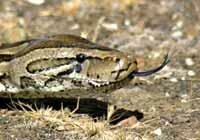Home > Don't just hike > Three SSS > Snakes
Slippery, slimy ...
Snakes
Python head

Snakes are part of nature and should be a wonder to see but the fear factor is always present. They hear you long before you see them. Whilst hiking in the Magaliesberg, one should remember we are trespassing on their territory.
Adders
These are very common and are found in or close to most major cities. Many of the snake bite cases reported come from adders. They have large fangs situated in the front of the mouth which, when they are not in use fold back against the roof of the mouth. Most have cytotoxic venom, which destroys tissue and blood vessels. Symptoms are localised but bites can be very painful and are often followed by severe swelling and occasionally blistering.
Elapids
Elapids include cobra and mambas and related snakes. They are venomous snakes with fixed grooved fangs in the front of the mouth and most of them are long and slender. The rinkals and the cobras are easily identified as they lift their heads off the ground and spread a hood. The venom of most is primarily nerotoxic; which affects the nervous system. The symptoms are rapid and can include dizziness, difficulty in swallowing, slurred speech, blurred vision and eventually unconsciousness.
Back-fanged snakes
These have small fangs on the upper jaw, just behind the eye. The boomslang and twig snake are known to have potent haemotoxic venom, which affects the blood-clotting mechanism, causing severe headaches, bleeding from the mucous membranes, nausea, vomiting and eventually bleeding from all internal organs.
Fangless and non-poisonous snakes
These do not possess venom, so are harmless, but they do have teeth. Some, like the large mole snake, are capable of painful bites.
Acknolwedgements: link


